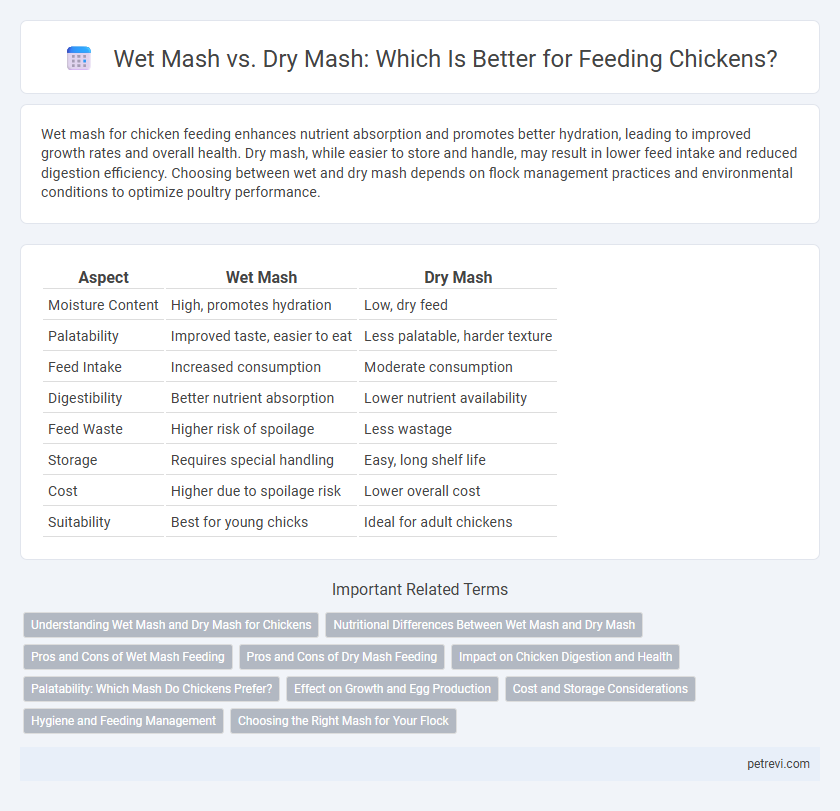Wet mash for chicken feeding enhances nutrient absorption and promotes better hydration, leading to improved growth rates and overall health. Dry mash, while easier to store and handle, may result in lower feed intake and reduced digestion efficiency. Choosing between wet and dry mash depends on flock management practices and environmental conditions to optimize poultry performance.
Table of Comparison
| Aspect | Wet Mash | Dry Mash |
|---|---|---|
| Moisture Content | High, promotes hydration | Low, dry feed |
| Palatability | Improved taste, easier to eat | Less palatable, harder texture |
| Feed Intake | Increased consumption | Moderate consumption |
| Digestibility | Better nutrient absorption | Lower nutrient availability |
| Feed Waste | Higher risk of spoilage | Less wastage |
| Storage | Requires special handling | Easy, long shelf life |
| Cost | Higher due to spoilage risk | Lower overall cost |
| Suitability | Best for young chicks | Ideal for adult chickens |
Understanding Wet Mash and Dry Mash for Chickens
Wet mash for chickens involves mixing dry feed with water to create a moist, easily digestible consistency that enhances nutrient absorption and promotes better hydration. Dry mash consists of finely ground feed particles served without added moisture, offering convenience and longer shelf life but potentially less palatability and slower digestion compared to wet mash. Choosing between wet and dry mash depends on factors such as bird age, climate, and feeding goals, with wet mash often preferred for young chicks and dry mash suited for older birds and dry conditions.
Nutritional Differences Between Wet Mash and Dry Mash
Wet mash feeds offer higher moisture content, enhancing digestibility and nutrient absorption in chickens compared to dry mash. Dry mash contains more concentrated nutrients by weight but may reduce water intake, potentially affecting feed efficiency. Balancing nutrient density and hydration is essential for optimizing growth and overall health in poultry nutrition.
Pros and Cons of Wet Mash Feeding
Wet mash feeding for chickens enhances nutrient absorption and increases water intake, promoting better digestion and growth rates. However, wet mash is prone to faster spoilage and requires more frequent feeding and cleaning to prevent bacterial contamination. Its higher moisture content can lead to wet litter conditions, potentially increasing the risk of footpad dermatitis in poultry.
Pros and Cons of Dry Mash Feeding
Dry mash feeding for chickens offers ease of storage and handling, reducing the risk of spoilage compared to wet mash. It promotes better dental and digestive health by encouraging natural pecking behavior, but may result in lower water intake if clean drinking water is not adequately provided. Dry mash also tends to produce less waste and contamination, making it a more hygienic and cost-effective option for poultry management.
Impact on Chicken Digestion and Health
Wet mash enhances chicken digestion by increasing water intake, which promotes smoother gastrointestinal transit and nutrient absorption. Studies indicate that wet mash reduces the risk of crop impaction and supports gut microbiota balance, leading to improved gut health and nutrient utilization. Conversely, dry mash may limit hydration and slow digestion, potentially causing digestive discomfort and suboptimal nutrient uptake in poultry.
Palatability: Which Mash Do Chickens Prefer?
Chickens generally prefer wet mash over dry mash due to its enhanced palatability and easier ingestion, which stimulates their natural feeding behavior. Wet mash increases moisture content, improving taste and aroma that attract chickens and encourage higher feed intake. Studies show chickens fed wet mash exhibit better growth performance and overall health compared to those receiving dry mash.
Effect on Growth and Egg Production
Wet mash feed for chickens improves nutrient absorption and supports faster growth rates compared to dry mash by enhancing palatability and hydration. Studies show that chickens consuming wet mash exhibit higher egg production and better feed conversion ratios due to increased digestive efficiency. Conversely, dry mash may reduce feed intake, potentially leading to slower growth and lower egg yield in intensive poultry farming.
Cost and Storage Considerations
Wet mash for chicken feeding generally incurs higher costs due to increased water usage and the need for frequent preparation to prevent spoilage, whereas dry mash is more cost-effective with longer shelf life and easier storage. Dry mash requires less space and has lower risk of fungal growth, making it ideal for bulk storage in varying environments. Choosing between wet and dry mash depends on balancing immediate feeding cost efficiency against storage conditions and feed freshness requirements.
Hygiene and Feeding Management
Wet mash for chicken feeding enhances feed palatability and increases water intake, promoting better digestion and nutrient absorption. However, it requires strict hygiene management to prevent microbial growth, as moisture creates a breeding environment for bacteria and molds. Dry mash offers easier storage and handling with reduced contamination risks, but may lead to lower feed consumption and hydration if not supplemented with adequate water.
Choosing the Right Mash for Your Flock
Choosing the right mash for your chicken flock significantly impacts nutrient absorption and overall health. Wet mash increases water intake and can enhance feed palatability, promoting faster growth and improved digestion, especially in young chicks or in hot climates. Dry mash offers convenience, longer shelf life, and reduced risk of spoilage, making it suitable for stable feeding routines and less labor-intensive management.
Wet mash vs Dry mash for Chicken Feeding Infographic

 petrevi.com
petrevi.com